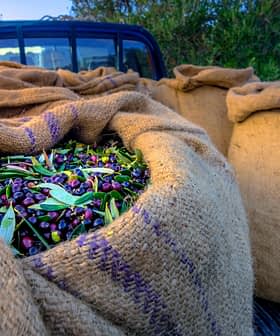Olive oil consumption in Italy and Greece — two of the world’s largest producers — is expected to rise in the current crop year, according to data from the International Olive Council (IOC).
Meanwhile, consumption in Spain and other producing countries is anticipated to slow down. Overall olive oil consumption in the European Union, responsible for nearly half of global consumption, is projected to fall considerably, from 1.6 to 1.4 million tons.
The scenario for the olive oil sector is not the best. The 2022/23 crop year, even if not concluded yet, will enter history as greatly defying expectations.
Experts believe the unusual forecast, which has not been seen in the last five crop years, is a consequence of converging factors.
Among them is the Mediterranean mega-drought, severely impacting olive production in Spain and other countries in the western half of the basin.
See Also:Bulk Exports from Greece Help Fuel the Italian Olive Oil IndustryAdditionally, high inflation has reduced household food budgets across the continent. Both inflation and the drought have resulted in rising olive oil prices too. These factors and the ongoing uncertainty of future harvests have affected consumption.
According to the IOC, Greek olive oil consumption will rise to 110,000 tons, up from 106,300 tons in the 2021/22 crop year but below the rolling five-year average.
“We all know olive oil is a huge part of Greek culture. Greece is among the leading countries in terms of per capita consumption of olive oil worldwide,” Stella Theodosiou, deputy director of the Greek olive oil producer association, Sevitel, told Olive Oil Times.
Theodosiou said per capita consumption in the country was estimated to be 11 kilograms per person in 2019/20. That year, Greek consumption was exceeded only by Spain, with 11.2 kilograms per person.
Theodosiou added that a 2021 study commissioned by the Greek Food Authority showed the ubiquity of extra virgin olive oil in Greek households and confirmed the role of small-scale production for domestic consumption.
“The majority of households, 57 percent, reported that they use extra virgin olive oil procured from relatives or friends,” she said. “Branded olive oils appeared to be linked to access to olive oil production, so 59 percent of those without access buy branded olive oils, compared to a very small number, 7 percent, of those who have access.”
Even so, the picture of olive oil consumption in Greece has significantly changed in recent years.
“Although the acceptance of olive oil is increasing, the Covid-19 pandemic and the increase of inflation directly affected consumption habits and finally changed them,” Theodosiou said.
According to Sevitel, a significant challenge for internal market development is the prevailing unbranded bulk sales, the “quality and safety [of which] are disputed,” Theodosiou said.
“Many years of research [indicate] that the sale of bulk olive oil is a practice that does not guarantee food safety in contrast to standardization and packaging up to 5 liters,” Theodosiou said.
Sevitel experts believe the olive sector must establish a long-term strategic plan soon.
“We consider Greece to be at a critical point to decide the content of a national strategy that will ensure the perspective and the future of Greek olive oil,” Theodosiou said.
Meanwhile, on the other side of the Ionian Sea, the IOC projected that Italian olive oil consumption would grow from 481,700 tons in 2021/22 to 486,500 tons in the current crop year.
Despite a significant decline in production due to drought and heatwaves, olive oil prices remaining high and inflation hurting household budgets, consumers were not deterred from investing in olive oil bottles.
“The scenario for the olive oil sector is not the best,” Andrea Carrassi, the general director of the Italian Association of the Edible Oil Industry (Assitol), told Olive Oil Times. “The 2022/23 crop year, even if not concluded yet, will enter history as greatly defying expectations.”
“In an off-year [in the natural alternate bearing cycle of the olive tree], we lost 50 percent of the national olive oil production to drought and extreme weather,” he added.
A recent study from Nomisma, a consultancy, investigated the progressive reduction of Italian olive oil production in the last few decades. Between 2010 and 2012, Italian production exceeded 500,000 tons. However, production volumes have fallen to 300,000 tons or below since 2020.
To counter the trend, farmers, millers, bottlers, exporters and the Ministry of Agriculture are working to establish an interprofessional organization.
The goal of the interprofessional would be to boost production through innovation, protecting traditional producers, stimulating olive tree cultivation and curtailing the spread of the deadly olive tree bacteria, Xylella fastidiosa.
“The industry is used to cope with the national production deficit, but [this season] it had to face way more challenging adversities than expected,” Carrassi said. “Olive farming through the Mediterranean has suffered, not only in Italy.”
Assitol estimated that consumption would rise to 600,000 tons, underscoring the disparity between consumption and local production, which fell to 235,000 tons in 2022/23.
“To this, we must add the troubles triggered by the rising costs of paper and glass, crucial packaging materials,” Carrassi said.
He added that the “moderate increase in olive oil consumption in Italy estimated by the IOC is good news, given the highly challenging moment.”
“We have always been among the first positions for olive oil consumption,” Carrassi said. “During the Covid-19 pandemic, Italians increased their purchases of healthy food products, including extra virgin olive oil, and this trend continues.”
Still, the Assitol general director underlined how much more must be done to make olive oil consumption globally grow.
“We have to highlight how this beloved product accounts for less than 5 percent of the global food fat consumption,” Carrassi said. “We have so much to do to promote this extraordinary food abroad. In Italy, we need to overcome the idea that olive oil is just an ingredient, giving value in any possible way to its sensory and healthy qualities.”









